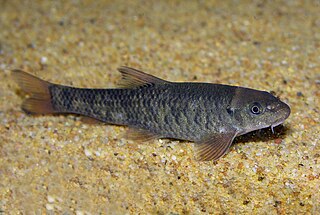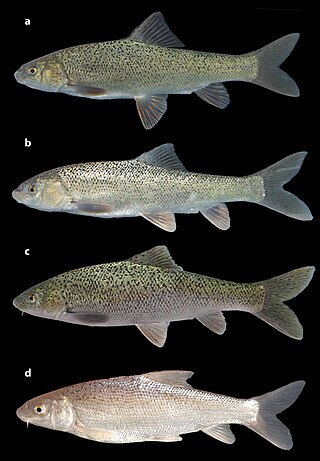
Barbus is a genus of ray-finned fish in the family Cyprinidae. The type species of Barbus is the common barbel, first described as Cyprinus barbus and now named Barbus barbus. Barbus is the namesake genus of the subfamily Barbinae, but given their relationships, that taxon is better included in the Cyprininae at least for the largest part.

Glyptothorax is a genus of catfishes order Siluriformes of the family Sisoridae. It is the most species-rich and widely distributed genus in the family with new species being discovered on a regular basis. These species are distributed in the Black Sea basin, northern Turkey, south and east to the Yangtze River drainage in China and south throughout Indo-China to Java, Indonesia. They are found in Asia Minor and southwards to Southeast Asia. The genus is very diverse in the Indian subcontinent. Southeast Asian species tend to have restricted distributions.

Alburnoides is a genus of cyprinid fishes native to Europe and Asia. Many species are known as riffle minnows or spirlins.

Alburnus is a genus of fish in the family Cyprinidae, the carps and minnows. They are known commonly as bleaks. A group of species in the genus is known as shemayas. The genus occurs in the western Palearctic realm, and the center of diversity is in Turkey.

Chondrostoma is a genus of ray-finned fish in the family Cyprinidae. They are commonly known as nases, although this term is also used locally to denote particular species, most frequently the common nase . The common name refers to the protruding upper jaw of these fishes; it is derived from the German term Nase 'nose'.

Cobitis is a genus of small freshwater fish in the family Cobitidae from temperate and subtropical Eurasia. It contains the "typical spiny loaches", including the well-known spined loach of Europe. Similar spiny loaches, occurring generally south of the range of Cobitis, are nowadays separated in Sabanejewia.

Garra is a genus of fish in the family Cyprinidae. These fish are one example of the "log suckers", sucker-mouthed barbs and other cyprinids commonly kept in aquaria to keep down algae. The doctor fish of Anatolia and the Middle East belongs in this genus. The majority of the more than 160 species of garras are native to Asia, but about one-fifth of the species are from Africa.

Gobio is a genus of typical gudgeons, ray-finned fish in the family Cyprinidae many of which are endemics of south-eastern Europe. Members of the genus are usually small fish, rarely longer than 10 cm.

Pseudophoxinus is a genus of fish in the family Cyprinidae found in Western Asia.
Squalius is a genus of fish in the family Cyprinidae found in Europe and Asia. Hybridization is not rare in the Cyprinidae, including this genus. S. alburnoides is known to be of ancient hybrid origin, with the paternal lineage deriving from a prehistoric species related to Anaecypris; the latter mated with ancestral S. pyrenaicus. Present-day S. alburnoides mates with sympatric congeners of other species.

Carasobarbus, the himris, is a small genus of ray-finned fishes in the family Cyprinidae. Its species are found in rivers, streams, lakes and ponds in Western Asia and Northwest Africa. C. canis can reach 66 cm (26 in) in total length, but most other species are up to around half or one-quarter of that size.

Paracapoeta erhani, also known as the Ceyhan scraper or Seyhan scraper, is a Turkish species of freshwater cyprinid fish in the genus Paracapoeta.

Leuciscinae is a subfamily of the freshwater fish family Cyprinidae, which contains the true minnows.
Oxynoemacheilus is a genus of fish in the family Nemacheilidae found in Europe and Western Asia.

Capoeta razii, is a newly described species of freshwater cyprinid fish occurring mainly in the southern Caspian Sea basin, Iran. This species was mistakenly reported by many authors as Capoeta gracilis in northern Iranian regions. It was first reported to be different from C. gracilis by Levin et al. (2012).
Capoeta alborzensis is a species of cyprinid in the genus Capoeta.
Paracapoeta anamisensis is a species of cyprinid in the genus Paracapoeta, native to Iran.
Capoeta ferdowsii is a species of cyprinid in the genus Capoeta, native the Zohreh and Fahlian rivers in Iran. It is named after Persian poet Ferdowsi.
Capoeta pyragyi is a species of cyprinid in the genus Capoeta. It lives in the Tireh and Sezar rivers of Iran, and it is named after Turkmen poet and spiritual leader Magtymguly Pyragy.

Paracapoeta is a genus of fish in the family Cyprinidae found in Mesopotamia, Cilicia and the Levant, Western Asia. This genus is closely related to Luciobarbus and was formerly the Mesopotamian clade of Capoeta before being split off in 2022. The generic name alludes to παρά meaning "near" and Capoeta.














